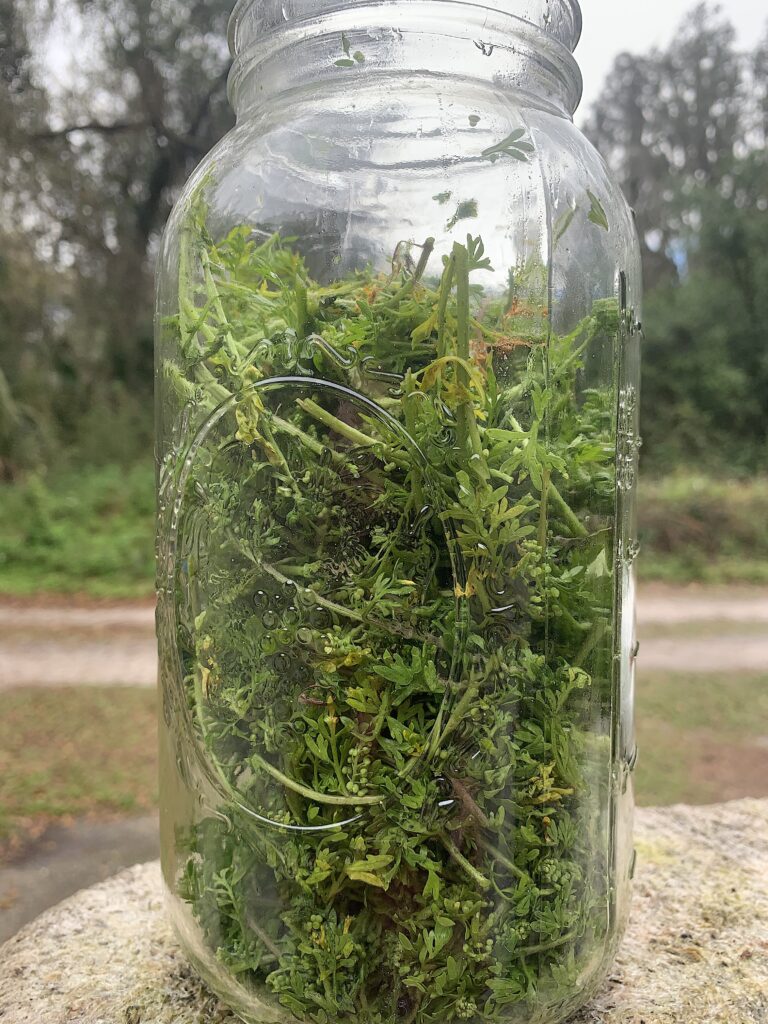
Preparing swine cress for fermenting. Photo by Green Deane
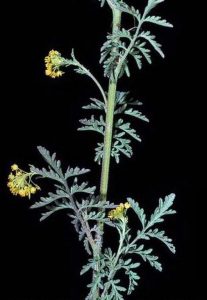
Western Tansy Mustard in bloom.
An end of season activity now is fermenting members of the mustard family. The two available extremes are swine cress and western tansy mustard. Swine cress is strong flavored and western tansy mustard is extremely mild. A third member is the common mustard blossoming on roadsides now as well. Fermenting vegetables make them sour, and preserves them. I’m also fermenting some radishes and their tops (which are in the mustard group, too.) All members of the mustard family are edible. Several common vegetables have been bred from the wild mustard including broccoli, cauliflower, cabbage, kale, kohlrabi and Brussels sprouts.
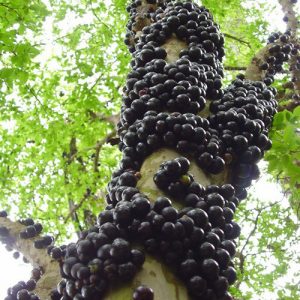
Jabuticaba fruit grows on the trunk and limbs of the tree.
In its native Brazil the Jabuticaba is by far the most popular fruit. The Dutch knew about it in 1658. Jabuticaba made it to California by 1904. It’s a common ornamental and there are many cultivars” Sabara, Paulista, Rajada, Branca, Ponhema, Rujada, Roxa, Sao Paulo, Coroa, Murta, and Mineira. Per 100 grams Plinia cauliflora fruit has 45.7 calories, 0.11 grams of protein, 0.08 grams of fiber, 0.01 grams of fat and 12.58 gams of carbohydrates. Vitamin A is absent but it has 22.7 mg of vitamin C which is about a third of your daily need. The B vitamins are B1 (thiamin) 0.02 mg, B2 (riboflavin) 0;02 mg, and B3 (niacin) 0.21 mg. Two minerals are reported: Calcium 6.3 mg and phosphorus 9.2 mg. It is also called Myrciaria cauliflora.
It’s a short tree planted in warm areas of North American and a common ornamental in Florida and the Gulf Coast. One is reported to sustain an 18F freeze and continued to thrive and fruit. Jabuticaba means “like turtle fat” referring to the fruit pulp, or, it means “tortoise place.” Take your pick. Myrciaria is from the Greek myrike (μυρίκη) which was the Greek name for the “tamarisk” a tree that is aromatic. In English it means Myrtle. Cauliflora means cauliflower-like. Plinia is Dead Latin for filled, full, rich, whole, perfect, well-equipped. You might remember from history Pliny the Elder and Younger.
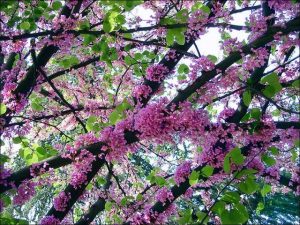
We’ve been nibbling the seasonal blossoms of the Eastern Redbud. Photo by Green Deane
Most trees in the Pea Family are toxic but not all of them. One of the edible ones is starting to blossom: The Eastern Redbud. The lanky tree is very easy to spot tis time of year because it has small pink blossoms and no leaves. Those small flowers — about the size of your fingernail — are important because there’s an ornamental tree with pink flowers also blossoming now that is not edible, the Pink Tabebuia. The Pink Tabebuia, however, has large blossoms about the same size as an Azalea blossom. The Eastern Redbud provides quite a few edibles: Tiny blossoms, young leaves, and pea pods. The Pink Tabebuia, T. heterophylla, does not have edible parts nor does two of its relatives, the Yellow Tabebuia, T. chrysotricha, and the Silver Trumpet Tree, T. caraiba. However, a fourth one in Florida, T. impetiginosa, or Purple Trumpet Tree, has seen its inner bark used as an herbal tea. Among those who have sipped and liked the tea was India’s Ghandi and Czar Nicholas II of Russia. You can read more about the Eastern Red Bud here, video here.
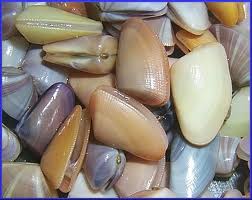
Coquina are tasty but quite small.
Sometime instead finding answers they find you. As you know there are several articles on the EatTheWeeds website that are about edibles covered by the subtitle: And other things, too. That subtitle was intentionally added when the site went up some 20 years ago. There are a lot of things in the world to eat. Before Andrew Zimmern was traipsing around the globe for the Travel Channel eating untraditional food EatTheWeeds was writing about them. As one might expect that has caused a good amount of disagreeing mail. Many people keep as pets creatures that other people eat. Thus far, however, no one has complained about Coquina, a coastal clam that’s about the size of your fingernail. The tiny clams make an absolutely delicious green broth that I like to add to — I know it’s sacrilege — instant potatoes and butter. One of the down sides is that the clams are so small getting the meat out of the shell is microscopic work. That is so frustrating as most of it is tossed away. However in Australia they figured out a commercial way of separating meat and shell. How that was done was something of a mystery until a post on the Green Deane Forum provided an answer. The cooked shells are vigorously stired. After that it is a matter of straining the shells from the meat. I’ve got to try that. You can read about Coquina here, and the crunchy Mole Crabs, here. A video on both of them is here.
Foraging Classes: Our weather may be moderating though historically February is the worst winter month of the year.

Foraging classes are held rain or shine, heat or cold. Photo by Nermina Krenata
Saturday, February 10th, Blanchard Park, 2451 Dean Rd, Union Park, FL 32817, meet beside the tennis courts. 9 a.m. to noon.
Sunday, February 11th, Colby-Alderman Park: 1099 Massachusetts Street, Cassadaga. Fla. 32706, 9 a.m. to noon, meet at the bathroom.
Saturday, February 17th, Bayshore Live Oak Park, Bayshore Drive. Port Charlotte, meet at the parking lot at Bayshore and Ganyard, 9 a.m. to noon.
Sunday, February 18th, Wickham Park: 2500 Parkway Drive, Melbourne, FL 32935-2335. 9 a.m. to noon, Meet at the “dog park”,
Saturday, February 24th, Mead Garden: 1500 S. Denning Dr., Winter Park, FL 32789. 9 a.m. to noon. Meet at the bathrooms.
Sunday, February 25th, Eagle Park Lake, 1800 Keene Road, Largo, FL 33771. Meet at the pavilion near the dog park. 9 a.m. to noon.

You get the USB, not the key.
172-video USB would be a good end of spring present and is now $99. My nine-DVD set of 135 videos has been phased out. The USB videos are the same videos I have on You Tube. Some people like to have their own copy. Most of the 172 USB videos have to be copied to your computer to play. If you want to order the USB go to the DVD/USB order button on the top right of this page. That will take you to an order form.

Green Deane Forum
Want to identify a plant? Perhaps you’re looking for a foraging reference? You might have a UFO, an Unidentified Flowering Object, you want identified. On the Green Deane Forum we — including Green Deane and others from around the world — chat about foraging all year. And it’s not just about warm-weather plants or just North American flora. Many nations share common weeds so there’s a lot to talk. There’s also more than weeds. The reference section has information for foraging around the world. There are also articles on food preservation, and forgotten skills from making bows to fermenting food.
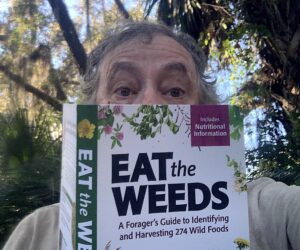
Finally, a physical copy of the book.
Now in print is EatTheWeeds, the book. It has 275 plants, 367 pages, index, nutrition charts and color photos. It’s available in many locations including Amazon. Most of the entries include a nutritional profile. It can also be ordered through AdventureKeen Publishing.
This is weekly newsletter #587. If you want to subscribe to this free newsletter you can find the sign-up form in the menu at the top of the page.
To donate to the Green Deane Newsletter click here.


Oh Green Deane, you tease us! What does the Jabuticaba taste like?
Is turtle fat the taste? Or the texture?
If that’s the taste, then what does turtle fat taste like?
Do tell!